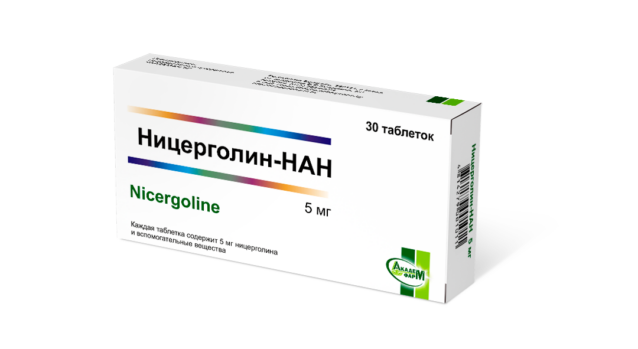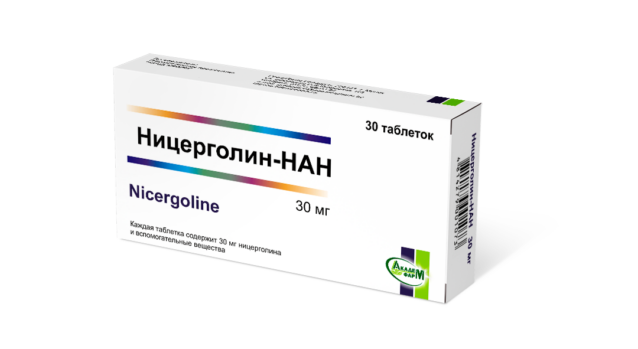Substance: Czech Republic
Nicergoline-NAN
International non-proprietary name: Nicergoline
Read carefully before use
Nicergoline-NAN
Nicergoline
Film-coated tablets
Nicergoline-NAN 5 mg: light-brown round biconvex film-coated tablets.
Nicergoline-NAN 10 mg: red-brown oval biconvex film-coated tablets.
Nicergoline-NAN 30 mg: brownish yellow oval biconvex film-coated tablets.
One Nicergoline-NAN tablet 5 mg contains:
Active substance: nicergoline 5 mg.
Auxiliary substances: microcrystalline cellulose, sodium carboxymethylcellulose, Kolliphor P188 micro poloxamer, magnesium stearate, anhydrous calcium hydrogen phosphate.
Coating composition: polyvinyl alcohol, titanium dioxide (E171), macrogol, talc, iron oxide yellow (E172), iron oxide red (E172), iron oxide black (E172).
One Nicergoline-NAN tablet 10 mg contains:
Active substance: nicergoline 10 mg.
Auxiliary substances: microcrystalline cellulose, sodium carboxymethylcellulose, Kolliphor P188 micro poloxamer, magnesium stearate, anhydrous calcium hydrogen phosphate.
Coating composition: polyvinyl alcohol, titanium dioxide (E171), macrogol, talc, iron oxide yellow (E172), iron oxide red (E172).
One Nicergoline-NAN tablet 30 mg contains:
Active substance: nicergoline 30 mg.
Auxiliary substances: microcrystalline cellulose, sodium carboxymethylcellulose, Kolliphor P188 micro poloxamer, magnesium stearate, anhydrous calcium hydrogen phosphate.
Coating composition: polyvinyl alcohol, titanium dioxide (E171), macrogol, talc, iron oxide yellow (E172), dye yellow “Sunset” (E110), iron oxide black (E172).
Peripheral vasodilators Ergot alkaloids
C04AE02
Nicergoline is an ergoline derivative with alpha-1-adrenergic blocking action. After oral administration, nicergoline is rapidly and extensively metabolized to form a number of metabolites, which also affect various levels of the CNS.
Neuropharmacological effect
After oral administration, nicergoline has various neuropharmacological effects, since it not only stimulates the uptake and subsequent utilization of glucose by the brain tissue, enhances the biosynthesis of proteins and nucleic acids, but also affects various neurotransmitter systems.
Nicergoline improved the functioning of cholinergic systems of brain in elderly animals. Chronic administration of nicergoline by elderly rats abolished the age-related decrease in acetylcholine levels (in cerebral cortex and striatum), as well as the decrease in acetylcholine release (in the hippocampus) in vivo. After prolonged oral administration of nicergoline, an increase in choline acetyltransferase activity and an increase in the density of muscarinic receptors were also observed. In addition, both in vitro and in vivo, nicergoline significantly increased the activity of acetylcholinesterase. These experiments showed a parallel dynamic of neurochemical changes and persistent improvements in behavioral responses.
Nicergoline also stimulates activity and translocation across the cell membrane of Ca-dependent isoforms of protein kinase C. These enzymes are involved in secretion of the soluble amyloid precursor protein, which leads to an increase in its release and a decrease in the production of pathological amyloid beta and that was demonstrated in a culture of human neuroblastoma.
Due to the antioxidant effect and activation of detoxification enzymes, nicergoline protected nerve cells from death caused by oxidative stress and apoptosis in vivo and in vitro. Nicergoline reduce the decrease in NO-synthase (nNOS) mRNA content in neurons that develops with age, which improves cognitive function.
Symptomatic treatment of mild and moderately severe dementia for the correction of cognitive and behavioral disorders.
Note: before starting treatment make sure that these symptoms are not a manifestation of another disease (for example, therapeutic, psychiatric or neurological) and do not require special treatment.
Dosage form
The recommended daily dose is 30-60 mg daily and can be divided into 1-3 doses with the same intervals between them. The dose and duration of treatment depend on the severity of symptoms and the patient’s individual response to treatment.
Elderly patients (over 65 years)
According to the studies of pharmacokinetics and nicergoline tolerability, no dose adjustment is required in elderly patients.
Children and adolescents (under 18 years)
Nicergoline is not for children and adolescents under 18 years of age. The safety and efficacy in children (under 18 years of age) have not been established.
Patients with renal impairment
Since nicergoline metabolites are excreted mainly by the kidneys, lower doses of nicergoline for use in patients with impaired renal function are recommended.
Dosage and administration
For oral use only. Tablets should be taken orally with food and without chewing once daily, drink small amount of water.
If Nicergoline-NAN is prescribed in a daily dose of 30 mg (1 tablet), it is recommended to take it at breakfast.
Since improvement in symptoms is usually observed after 4-6 weeks from the start of administration, it is recommended to take Nicergoline-NAN for a long period of time. The duration of Nicergoline-NAN therapy in accordance with the recommendations is not limited in time, but at certain intervals (at least once every 6 months), the doctor must evaluate the feasibility of treatment continuation.
Concurrent reactions are presented by classes of organ systems and occurrence rate: very common (≥ 1/10), common (≥1/100, but < 1/10), uncommon (≥1/1000, but < 1/100), rare (≥1/10000, but <1/1000), very rare (<1/10000), frequency is unknown (cannot be estimated based on available data).
Psychiatric symptoms: uncommon – hyperactivity, confusion, insomnia.
Nervous system disorders: uncommon – drowsiness, dizziness, headache; not known – hot flushes or flushing.
Vascular disorders: uncommon – hypotension, hyperaemia.
Gastrointestinal disorders: common – abdominal discomfort; uncommon – constipation, nausea, diarrhoea.
Skin and subcutaneous tissue disorders: uncommon – itchiness; not known – rash.
General disorders and administration site conditions: not known – fibrosis, nasal congestion.
Investigations: uncommon – uric acid levels increase in the blood.
If any of the undesirable effects listed in the instructions worsen, or you notice any other undesirable effects not listed in the instructions, inform your doctor about it.
- Hypersensitivity to nicergoline, other ergot alkaloids or other components of the medicine.
- Patients with recent myocardial infarction.
- Acute bleeding.
- Threat of collapse or tendency to collapse.
- Severe bradycardia (<50 bpm).
- Orthostatic dysregulation.
- Children and adolescents under 18 years of age (safety and administration efficiency in children under 18 years is not established).
If taking a larger dose than prescribed by your doctor, immediately contact specialists to provide timely medical care!
Symptoms: transient pronounced decrease in blood pressure.
Treatment: special treatment is usually not required; it is enough for the patient to take a horizontal position for a few minutes. In exceptional cases (a sharp violation of the blood supply to the brain and heart) introduction of sympathomimetic medicines with constant blood pressure control is recommended.
If you forget to take Nicergoline-NAN do not take double dose to make up for a forgotten tablet, take your next dose at its usual time.
Nicergoline should be used with caution with the following medicinal products:
Antihypertensive agents: nicergoline may enhance their therapeutic effect. Nicergoline can potentiate the cardiotropic effect of beta-blockers.
Sympathomimetics (alpha and beta): nicergoline reduces the vasoconstrictor effect of sympathomimetics, as it is an alpha-blocker.
Medicines metabolized by CYP 2D6: since nicergoline is metabolized by cytochrome CYP 2D6, the possibility of its interaction with medicines that are metabolized by the same enzyme system cannot be ruled out.
Antiplatelet agents and anticoagulants (for example, acetylsalicylic acid): increases the effect on hemostasis and thus may potentiate prolongation of bleeding time.
Medicines affecting the metabolism of uric acid: nicergoline can lead to asymptomatic increase in the level of uric acid in the blood serum.
Inform your doctor about all medications you are taking. Consult your doctor before you start taking any medication during treatment with Nicergoline-NAN medicinal product.
Studies using single or multiple doses of nicergoline have shown that Nicergoline-NAN can lead to a decrease in systolic pressure and (to a lesser extent) diastolic pressure in normotensive patients and patients with high blood pressure. Other studies have not found this effect.
Sympathomimetics (alpha or beta) should be used with caution in patients treated with nicergoline (see Section Interaction with other medicines).
Fibrosis (for example, pulmonary, cardiac, valvular, and retroperitoneal) has been observed with some ergot alkaloids that exhibit 5-HT2β serotonin receptor agonist activity. Symptoms of ergotism (including nausea, vomiting, diarrhea, abdominal pain, and peripheral vasoconstriction) have been reported with ingestion of certain ergot alkaloids and their derivatives. When prescribing this class of medicines, clinicians and healthcare providers should be aware of the signs and symptoms of ergot overdose.
Nicergoline can be used in patients with mild bradycardia (with special precautions).
Cerebral circulation disorders can also be a manifestation of such diseases as heart failure, arrhythmias or hypertension. In case of such diseases, it is necessary to start with their treatment.
Nicergoline inhibits platelet aggregation and reduces blood viscosity. Patients who have conditions which may predispose them to disorders should regularly monitor parameters of their blood coagulation system. The same control should be adopted when starting treatment with nicergoline in patients simultaneously receiving anticoagulants (see Sections Interactions with other medicines and Side effects).
Nicergoline-NAN should be used with caution in a history of hyperuricemia or gout and/or in combination with medicines that can affect metabolism and excretion of uric acid.
If you have one of the diseases or conditions listed above, be sure to consult your doctor before taking the medicinal product.
Special studies during pregnancy have not been conducted. It is unlikely that nicergoline will be prescribed to pregnant women and nursing mothers (given the indications for use). Administration of Nicergoline-NAN during pregnancy is possible under the direct supervision of a physician and only if the potential benefits outweigh the potential risks to the fetus and child.
Since the possibility of nicergoline penetration into breast milk has not been established, the use of nicergoline during breastfeeding is not recommended.
Studies of the effect of nicergoline on the ability to drive vehicles and control potentially dangerous mechanisms have not been conducted. Influence of the underlying disease on these activities should be taken into account when prescribing Nicergoline-NAN.
When taking nicergoline blood pressure may decrease and patients may experience weakness, dizziness or drowsiness.
Nicergoline-NAN therapy requires regular medical monitoring. The ability to drive and use potentially dangerous machines may be affected by individual reactions to Nicergoline-NAN, especially when starting treatment and/or in combination with alcohol.
Film-coated tablets, 5 mg, 10 mg and 30 mg. 15 or 25 tablets in a blister made of three-layer film (PVC/PE/PVDC) and flexible packing based on aluminum foil. 2 blisters with a patient information leaflet, packed in a carton.
Protect from light and moisture, at a temperature not above 25°C.
Keep away from children.
2 years. Do not use after the expiration date indicated on the packing.
State enterprise ACADEMPHARM
220141, 5/3 Kuprevicha Street, Minsk, Belarus
Phone / Fax +375 17 268 63 64
production@academpharm.by
To report adverse reactions use the electronic application form on the manufacturer’s website: https://academpharm.by/en


